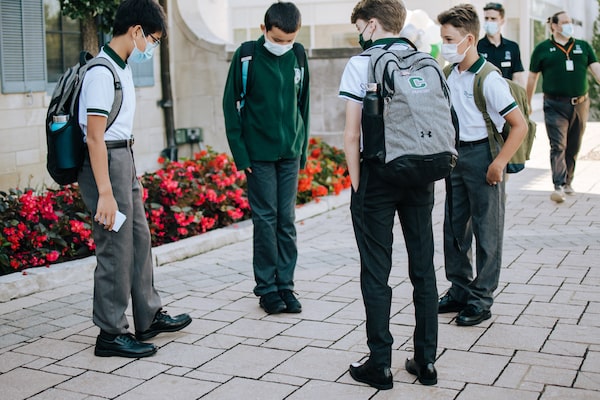
Crescent School in Toronto has a mentorship program so students have an adult they can turn to if they need help.Handout
Prior to returning to in-person classes last year, Kirsten Bowles, the junior school counselling department head for Vancouver’s independent West Point Grey Academy, knew her students were going to need additional support.
“Staff education and wellness became one of a few priorities beginning last September,” she says.
Bowles says the training sessions included one for parents, called “mental health and our kids,” and a staff-wide presentation on “mental health literacy.”
West Point Grey also took the pandemic as an opportunity to expand its CARE (Confident, Authentic, Respectful, Empathetic) program, which teaches students about mental health and wellness starting from junior kindergarten, focusing on a new theme each month. For example, September’s theme is self-awareness, and in the months ahead the students will learn about gratitude, kindness, courage, leadership, and perspective.
“For children, it’s about developing self awareness, which is so important for so many other soft skills and relationships and successes in life,” says Bowles. “To become self aware, to know what one thinks and feels, what one needs, how to express oneself, all of those things start from recognizing thoughts, emotion and impulses.”
As early as 2014, Canadian researchers have been sounding the alarm over the rising volume of children and youth seeking mental health services, and the lack of adequate resources available to support them.
“All of that had been climbing before the pandemic,” says Dr. Stephanie Ameis, a psychiatrist and associate director of the Cundill Centre for Child and Youth Depression at CAMH. “We have definitely seen a huge increase in our wait times because of the number of referrals that we’re getting.”

Crescent School also developed what it calls the STEM 1.0 program, an acronym that stands for Sleep, Think, Eat and Move.Handout
According to a recent study conducted by Sick Kids, more than 70 per cent of school aged children and 66 per cent of preschool aged children reported deterioration in at least one of six mental health domains during the pandemic. Those domains include depression, anxiety, irritability, attention span, hyperactivity, and obsession/compulsion.
Even before the disruptions and distresses of the pandemic, mental health resources for children and youth in Canada were struggling to meet demand. That is especially true in Ontario, where there are an estimated 28,000 children currently on a waitlist for mental health services, some of whom will wait more than two years for treatment.
Dr. Ameis, however, believes private schools are well-equipped to support their students’ mental health needs.
“The private schools are really in a great position to integrate the social and emotional learning into their curriculums, to teach their staff to identify those students that are in need, and also have these more seamless networks to [provide additional resources] to students who are struggling in a timely way,” she says.
These priorities are also in line with the three tiers of Ontario’s School Mental Health Action Plan for the 2021 and 2022 school year, which similarly focus on knowledge and skill building, early intervention, and support systems. It also echoes the strategies and programs many private academic institutions had established previously, and further developed during the pandemic.
Programs like West Point Grey’s CARE initiative are designed to facilitate mental health literacy, creating a common language for students and teachers while de-stigmatizing the topic of mental health.
“With the empowerment they feel to put their hand up about things, particularly when they’re worried about their friends, they have a language now that may not have existed in the past,” explains Laura Poce, the acting vice-principal of student success at The Bishop Strachan School, a Toronto-based private school for girls.
“Mental health and mental wellbeing, suicide ideation, anxiety and stress and eating disorders are talked about in a language they can use when talking to an adult about a friend.”
Poce adds that during the pandemic teachers underwent additional training to better identify signs and symptoms of mental health challenges. The strategy is in response to a growing body of research that underscores the importance of having a “trusted adult” young people can talk to outside of their family, and a strategy that private schools have found effective in the past.
“We have a mentorship program, and that program ensures that each of our students has an adult that they can go to in the school should they need any kind of assistance,” says Gina Kay, the executive director of students services at Crescent School, a Toronto-based private school for boys. “The feedback we get from our students, and from our teachers, is that it’s just a wonderful, supportive program.”
Kay explains that students meet in groups of 10 to 12 with their designated staff mentor twice a week. Crescent School also developed what it calls the STEM 1.0 program, an acronym that stands for Sleep, Think, Eat and Move.
“All programming that we do, especially in the mentor groups, often focuses on the STEM 1.0 program, and we really instil in our students the importance of this; that in order to be healthy and functional at school and feel good about yourself you need to take care of your STEM 1.0,” she says.
Mental health education, mentorship, and support, coupled with an emphasis on maintaining a healthy lifestyle, can go a long way in reducing mental health problems among students. There are, however, some challenges that can’t be solved by teachers alone, which is why many private schools provide direct access to mental health professionals, such as social workers, therapists and counsellors, on-site.
“We recognize that there will be some students who may need some additional support, and that is where our social workers might come in,” Kay says. “That level of support can increase depending on the needs of the students at the time.”
Looking for more stories about private school education? Get the latest on curriculum trends, financial assistance and the pandemic’s impact here.